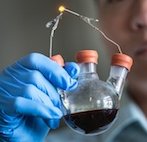U.S. researchers believe a breakthrough in battery technology will see more utility-scale solar and wind energy powering national grids.
Scientists from the U.S. Department of Energy’s (DOE) SLAC National Accelerator Laboratory and Stanford University have designed a new low-cost flow battery storage system that could solve issues relating to the peaks and troughs in power generation from renewable energy sources.
Flow batteries pump two types of liquid through a chamber, where two streams of dissolving molecules cause a chemical reaction that store or release energy.
They are currently thought to be the most effective way to maintain grid stability because the tanks, pipes and fittings used in flow battery systems can be scaled-up to store power for large-scale solar and wind facilities where energy generation depends on weather conditions.
But today’s flow batteries are expensive – the liquids used often require large quantities of rare earth materials to operate and a special membrane that separates the active and inactive ions. According to the SLAC/Stanford team, with solar and wind heading toward 20 percent of generation capacity, there needs to be a simpler and more efficient flow battery system.
“For solar and wind power to be used in a significant way, we need a battery made of economical materials that are easy to scale and still efficient,” said Yi Cui, Stanford associate professor of materials science and engineering.
Cui’s team designed a new membrane-free battery that does away with rare materials, using a chamber with a single molecular stream of lithium and sulphur ions. A reaction with a catalyst produces lithium polysulfides, discharging energy and absorbing lithium. The lithium ions are then reabsorbed into an organic compound to be used again.
“In initial lab tests, the new battery also retained excellent energy-storage performance through more than 2,000 charges and discharges, equivalent to more than 5.5 years of daily cycles,” Cui said.
The researchers say the next step is to develop and field test a utility-scale flow battery based on their design capable of handling megawatts of energy storage.
Another flow battery concept we’ve covered in the past utilising cheap and readily available materials is the Rustbelt Flow Battery; which uses iron.
Source/image source







































